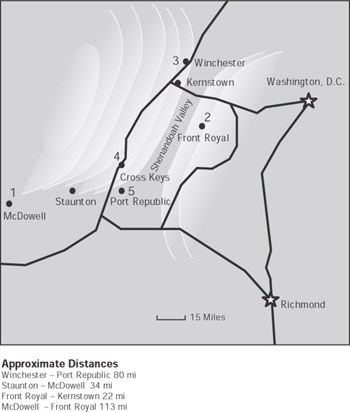Stonewall Jackson - Press On
Stonewall Jackson ” Press On
Embodying his mantra of Press on. Press on, men, Lieutenant General Thomas Stonewall Jackson led his Confederate troops on a series of quick strikes in the Shenandoah Valley between May 23 and June 9, 1862, and forced the much larger Union Army into a constant state of off-balanced reaction to his initiatives. [6]
During the Spring of 1862 three separate Union armies, outnumbering Jackson s forces by three to one, occupied several outposts throughout the valley. Undaunted, Jackson devised a brilliant plan to strike these outposts in succession, destroy the larger Union Army in detail, and deny the Union a southerly route through the valley into the heart of the Confederate States. [7] The key to his transitory hit and move strategy was rapid movement between points, which would enable his forces to attack with local numerical superiority before Union reinforcements from adjacent outposts could arrive .
Given the importance of mobility to his plan, Jackson memorized the distances between the towns in the valley to estimate travel time between points, and he located every improved road to identify the quickest marching routes for his troops. Moreover, he used trains to ferry troops from one attack site to the next and marched his men at breakneck speed, sometimes with nothing more than a bare minimum of food, clothing, and ammunition .
Beginning with a battle in the small western valley town of McDowell on May 8, Jackson crisscrossed the valley on a whirlwind series of attacks. With all the speed he could muster, Jackson ferried six thousand of his troops by foot and train to McDowell to defeat an isolated Union force of twenty-three hundred men. This victory, though seemingly small, set the tone for a series of sluggish Union reactions to his unpredictable moves.
He then advanced 120 miles to the northeast to strike Front Royal on May 23, where his forces inflicted more than 900 casualties on a 1,000-man Union force, and north to Winchester on May 25, where his forces routed a force of more than 6,000 men. After reaching Harpers Ferry and posing a threat to northern soil, which further distracted the Union from the Confederate States, Jackson then turned south and raced 100 miles to strike the Union at Cross Keys on June 8 and Port Republic on June 9.
During this whirlwind series of attacks, Jackson s forces repeatedly routed their Union opponents and on more than one occasion used speed to narrowly escape envelopment from reinforcements. In five weeks Jackson s Army covered more than 600 miles, captured 3,500 prisoners , inflicted 6,900 casualties, at a cost of fewer than 2,500 casualties, while safeguarding both the valley and the Confederate States from the Union. [8]

Figure 9.1: Stonewall Jackson s Valley Campaign, May “June, 1862
Leadership Lessons
Jackson s campaign embodies tempo in a multiarena encounter because he kept his opponent off balance by striking at multiple points in rapid succession. The much larger Union Army never knew where or when the next attack would come, thereby enabling Jackson to dictate the terms of battle. By the time his opponent reacted to one of his strikes, he was already moving in another direction, rendering the response inappropriate and ineffective .
Jackson knew that he could not withdraw from his much larger opponent without jeopardizing the very survival of the Confederacy. He also knew that, given his numerical inferiority, he could not allow the Union to gain the initiative, maneuver into a position of advantage, and bring its overwhelming strength to bear on his forces. Thus he chose to seize the initiative, isolate the Union forces unit by unit, and defeat them in detail. In so doing, he used familiarity with the local geography and transportation infrastructure ” roads and railroads ”to accelerate his rate of maneuver.
[6] Foote, Shelby, The Civil War ”A Narrative: Fort Sumter to Perryville , 453.
[7] Imboden, John D., B Gen, CSA, Stonewall Jackson in the Shenandoah.
[8] U.S. National Park Service, Study of Civil War Sites in the Shenandoah Valley, September 1992.
EAN: 2147483647
Pages: 145